Inverse Analysis for the Convergence-Confinement Method in Tunneling
Abstract
:1. Introduction
2. Problem Description
2.1. Relationship between Confinement Loss and Unsupported Span
2.2. Explicit Algorithm Process of the Inverse Calculation Method (ICM)
3. Equations Derivation of the Inverse Calculation Method (ICM)
3.1. Support-Ground Interaction Occurred in the Elastic State
3.2. Support-Ground Interaction Occurred in the Plastic State
4. Comparison of Results of ICM with Other Studies
4.1. Validation of Results Obtained by Direct Analysis (DCM) and Inverse Analysis (ICM)
4.2. Comparison of Calculation Results between ICM and Other Studies
5. Case Study of the Railway Tunnels
5.1. General Geology, Preliminary Data, Tunnel Design, and Monitoring Data
5.2. Establishment of Confinement Loss Curve (CLC)
5.3. Results Obtained by the Direct Analysis (DCM)
5.4. Results Obtained by the Inverse Analysis (ICM)
6. Conclusions
Author Contributions
Funding
Informed Consent Statement
Conflicts of Interest
References
- Finno, R.J.; Calvello, M. Supported excavations: The observational method and inverse modeling. J. Geotech. Geoenviron. Eng. 2005, 131, 826–836. [Google Scholar] [CrossRef]
- Mauldon, A.D.; Karasaki, K.; Martel, S.; Long, J.C.S.; Landsfeld, M.; Mensch, A.; Vomvoris, S. An inverse technique for developing models for fluid flow in fracture systems using simulated annealing. Water Resour. Res. 1993, 29, 3775–3789. [Google Scholar] [CrossRef]
- Gioda, G.; Sakurai, S. Back analysis procedures for the interpretation of field measurements in geomechanics. Int. J. Numer. Anal. Methods Geomech. 1987, 11, 555–583. [Google Scholar] [CrossRef]
- Oreste, P. Back-analysis techniques for the improvement of the understanding of rock in underground constructions. Tunnell. Undergr. Space Technol. 2005, 20, 7–21. [Google Scholar] [CrossRef]
- Luo, Y.B.; Chen, J.X.; Chen, Y.; Diao, P.S.; Qiao, X. Longitudinal deformation profile of a tunnel in weak rock mass by using the back analysis method. Tunnell. Undergr. Space Technol. 2018, 71, 478–493. [Google Scholar] [CrossRef]
- Sharifzadeh, M.; Tarifard, A.; Moridi, M.A. Time-dependent behavior of tunnel lining in weak rock mass based on displacement back analysis method. Tunnell. Undergr. Space Technol. 2013, 38, 348–356. [Google Scholar] [CrossRef]
- Sakurai, S.; Takeuchi, K. Back analysis of measured displacements of tunnels. Rock Mech. Rock Eng. 1983, 16, 173–180. [Google Scholar] [CrossRef]
- Sakurai, S. Lessons learned from field measurements in tunneling. Tunnell. Undergr. Space Technol. 1998, 12, 453–460. [Google Scholar] [CrossRef]
- Sakurai, S.; Akutagawa, S.; Takeuchi, K.; Shinji, M.; Shimizu, N. Back analysis for tunnel engineering as a modern observational method. Tunnell. Undergr. Space Technol. 2003, 18, 185–196. [Google Scholar] [CrossRef]
- Gao, W.; Ge, M. Back analysis of rock mass parameters and initial stress for the Longtan tunnel in China. Eng. Comput. 2016, 32, 497–515. [Google Scholar] [CrossRef]
- Li, F.; Wang, J.A.; Brigham, J.C. Inverse calculation of in situ stress in rock mass using the surrogate-model accelerated random search algorithm. Comput. Geotech. 2014, 61, 24–32. [Google Scholar] [CrossRef]
- Zhang, L.Q.; Yue, Z.Q.; Yang, Z.F.; Qi, J.X.; Liu, F.C. A displacement-based back-analysis method for rock mass modulus and horizontal in situ stress in tunneling–Illustrated with a case study. Tunnell. Undergr. Space Technol. 2006, 21, 636–649. [Google Scholar] [CrossRef]
- Diao, H.; Liu, H.; Sun, B. On a local geometric property of the generalized elastic transmission eigenfunctions and application. Inverse Probl. 2021, 37, 105015. [Google Scholar] [CrossRef]
- Fang, X.; Deng, Y. Uniqueness on recovery of piecewise constant conductivity and inner core with one measurement. Inverse Probl. Imaging 2018, 12, 733–743. [Google Scholar] [CrossRef] [Green Version]
- Deng, Y.; Li, H.; Liu, H. Spectral Properties of Neumann-Poincaré Operator and Anomalous Localized Resonance in Elasticity Beyond Quasi-Static Limit. J. Elast. 2020, 140, 213–242. [Google Scholar] [CrossRef] [Green Version]
- Panet, M. Le Calcul des Tunnels par la Méthode de Convergence-Confinement; Presses de l’Ecole Nationale des Ponts et Chaussées: Paris, France, 1995. [Google Scholar]
- Carranza-Torres, C.; Fairhurst, C. Application of the convergence-confinement method of tunnel design to rock masses that satisfy the Hoek–Brown failure criterion. Tunnell. Undergr. Space Technol. 2000, 15, 187–213. [Google Scholar] [CrossRef]
- Oreste, P. Analysis of structural interaction in tunnels using the convergence-confinement approach. Tunnell. Undergr. Space Technol. 2003, 18, 347–363. [Google Scholar] [CrossRef]
- Oreste, P. The convergence–confinement method: Roles and limits in modern geomechanical tunnel design. Am. J. Appl. Sci. 2009, 6, 757–771. [Google Scholar] [CrossRef] [Green Version]
- Rocksupport. Rock Support Interaction and Deformation Analysis for Tunnels in Weak Rock; Tutorial Manual of Rocscience Inc.: Toronto, ON, Canada, 2004; pp. 1–76. [Google Scholar]
- Lee, Y.L. Explicit analysis for the ground-support interaction of circular tunnel excavation in anisotropic stress fields. J. Chin. Inst. Eng. 2020, 43, 13–26. [Google Scholar] [CrossRef]
- Lee, Y.L. Explicit procedure and analytical solution for the ground reaction due to advance excavation of a circular tunnel in an anisotropic stress field. Geotech. Geol. Eng. 2018, 36, 3281–3309. [Google Scholar] [CrossRef]
- Brown, E.T.; Bray, J.W.; Ladanyi, B.; Hoek, E. Ground response curves for rock tunnels. J. Geotech. Eng. ASCE 1983, 109, 15–39. [Google Scholar] [CrossRef]
- Carranza-Torres, C.; Engen, M. The support characteristic curve for blocked steel sets in the convergence-confinement method of tunnel support design. Tunnell. Undergr. Space Technol. 2017, 69, 233–244. [Google Scholar] [CrossRef]
- De La Fuente, M.; Taherzadeh, R.; Sulem, J.; Nguyen, X.S.; Subrin, D. Applicability of the convergence-confinement method to full-face excavation of circular tunnels with stiff support system. Rock Mech. Rock Eng. 2019, 52, 2361–2376. [Google Scholar] [CrossRef]
- Gschwandtner, G.G.; Galler, R. Input to the application of the convergence confinement method with time-dependent material behavior of the support. Tunnell. Undergr. Space Technol. 2012, 27, 13–22. [Google Scholar] [CrossRef]
- Lee, Y.L. Establishment of the confinement loss curve using the tunnel convergence data. J. Chin. Inst. Eng. 2020, 43, 613–627. [Google Scholar] [CrossRef]
- Mousivand, M.; Maleki, M.; Nekooei, M.; Msnsoori, M.R. Application of Convergence-Confinement method in analysis of shallow non-circular tunnels. Geotech. Geol. Eng. 2017, 35, 1185–1198. [Google Scholar] [CrossRef]
- Vlachopoulos, N.; Diederichs, M. Improvement to the convergence-confinement method: Inclusion of support installation proximity and stiffness. Rock Mech. Rock Eng. 2018, 51, 1495–1519. [Google Scholar] [CrossRef]
- Serafim, J.L.; Pereira, J.P. Consideration of the geomechanical classification of Bieniawski. In Proceedings of the International symposium on engineering geology and underground construction, Lisbon, Portugal, 12–15 September 1983; Volume 1, pp. 1133–1144. [Google Scholar]
- Bieniawski, Z.T. Determining rock mass deformability—Experience from case histories. Int. J. Rock Mech. Min. Sci. 1978, 15, 237–247. [Google Scholar] [CrossRef]
- Nicholson, G.A.; Bieniawski, Z.T. A Nonlinear deformation modulus based on rock mass classification. Int. J. Min. Geol. Eng. 1990, 8, 181–202. [Google Scholar] [CrossRef]
- Read, S.A.L.; Perrin, N.D.; Richards, L.R. Applicability of the Hoek-Brown failure criterion to New Zealand Greywacke rocks. In Proceedings of the 9th ISRM Congress, Paris, France, 25–28 August 1999. [Google Scholar]


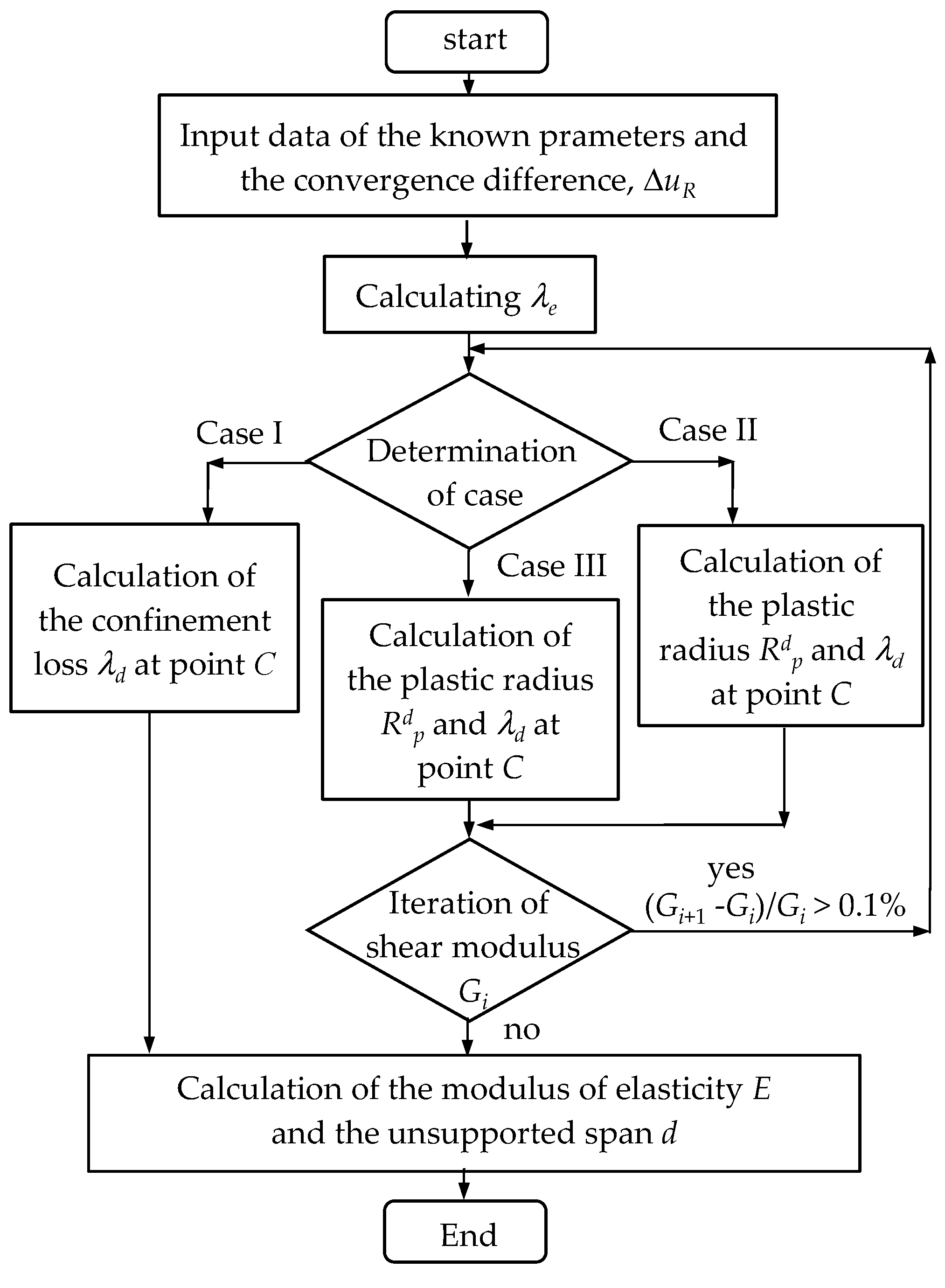
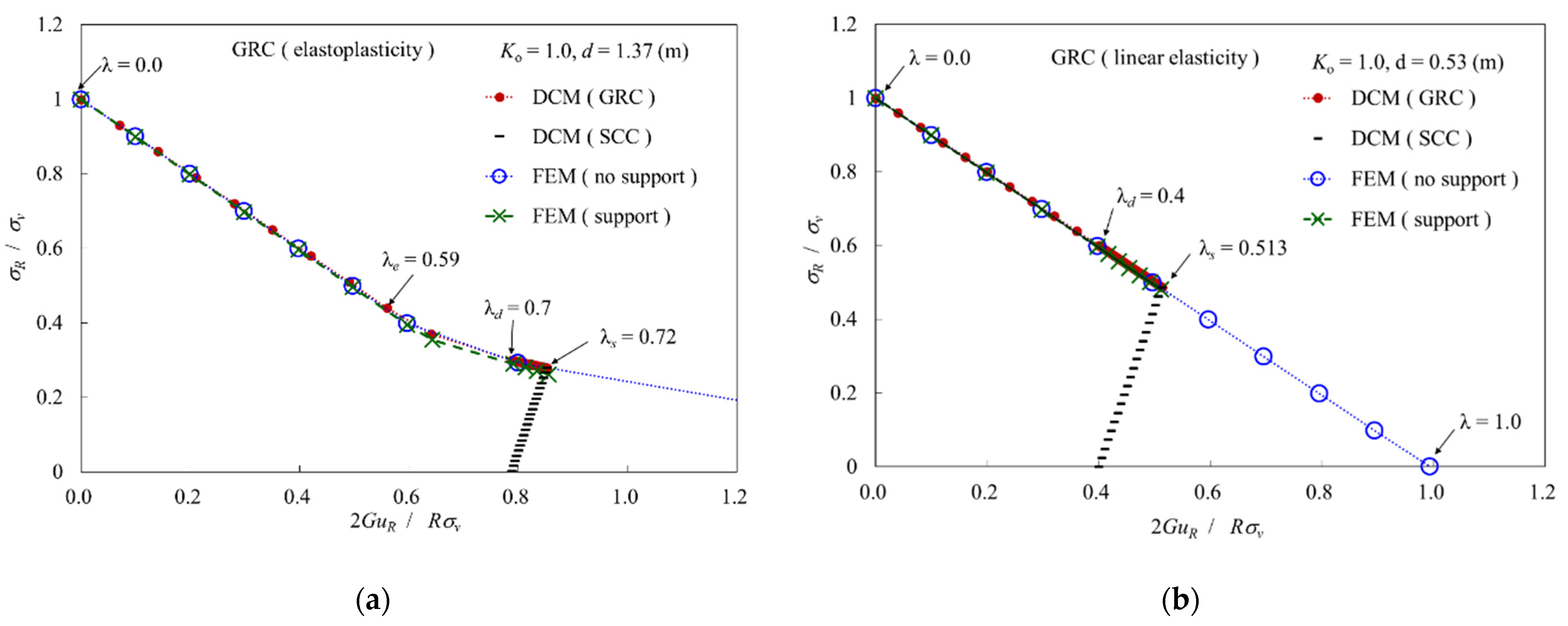


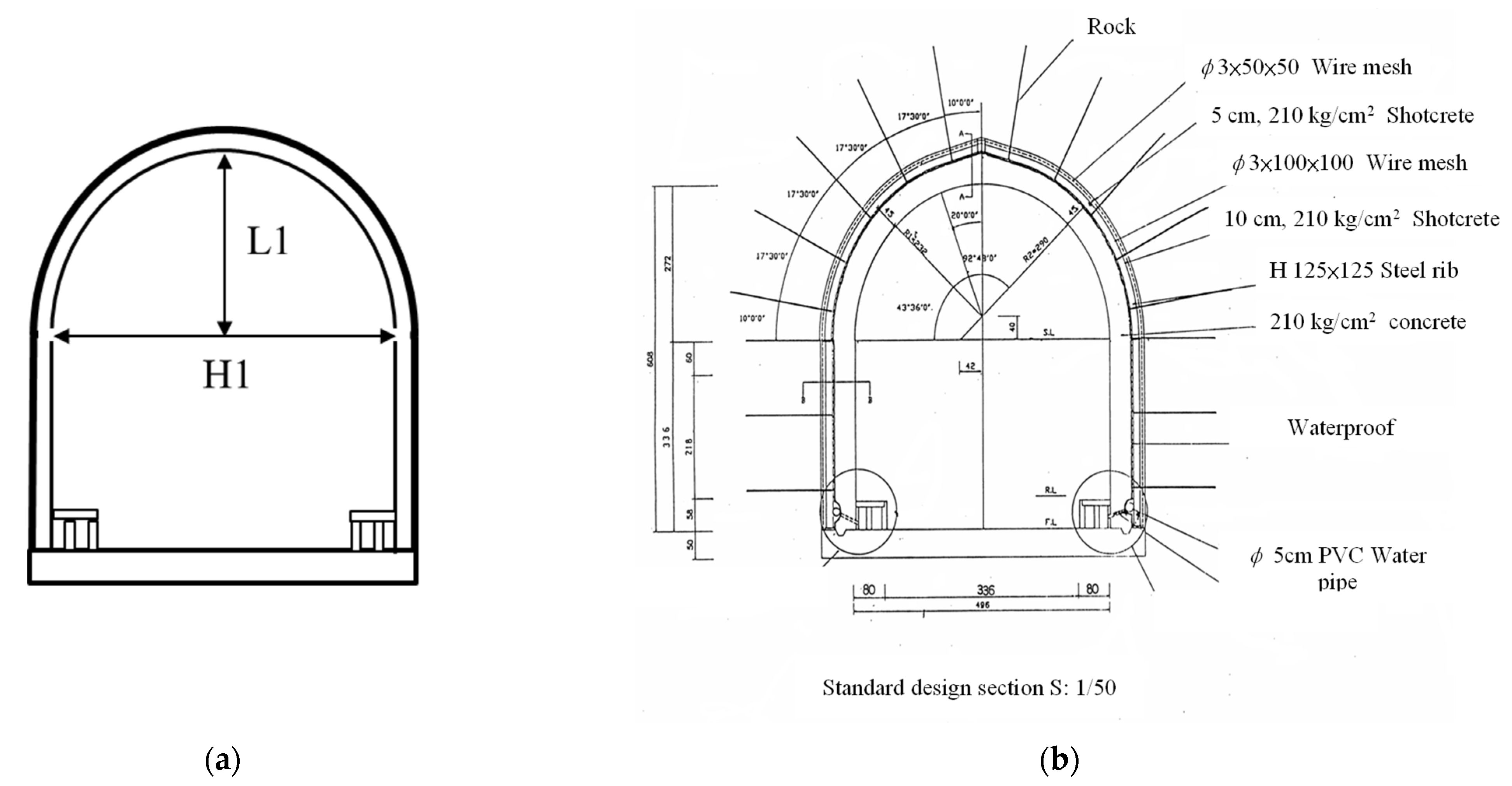
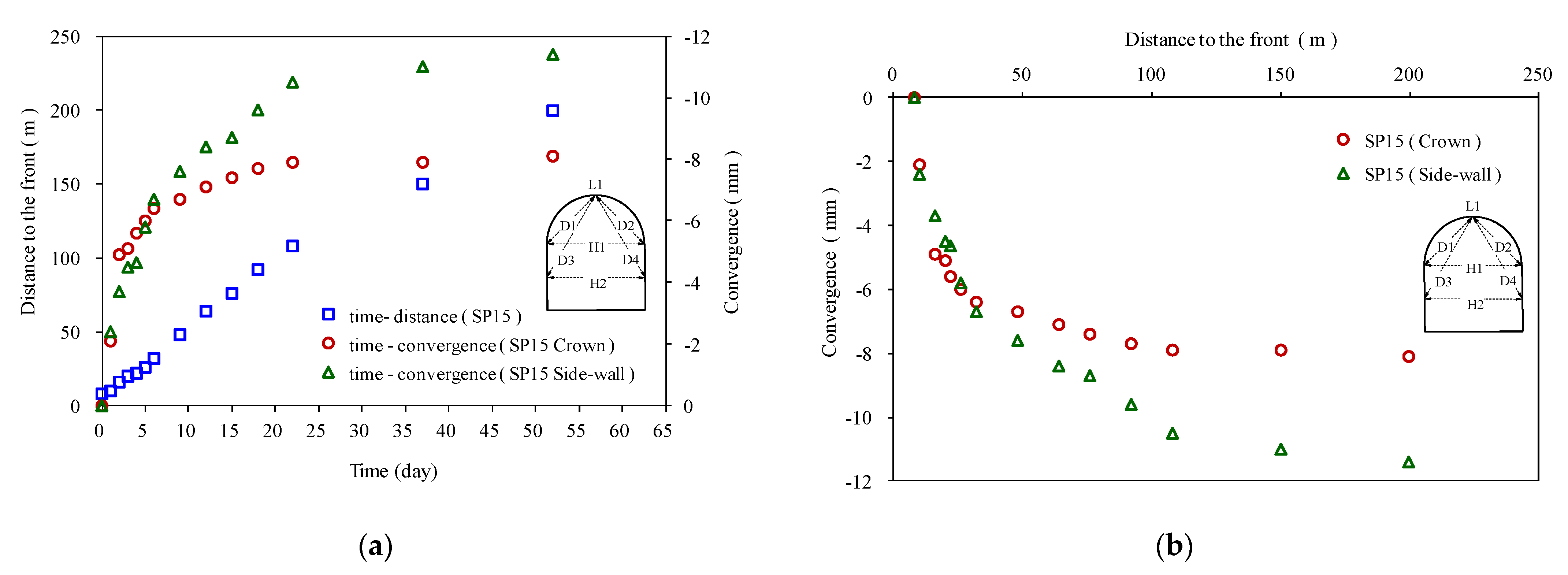
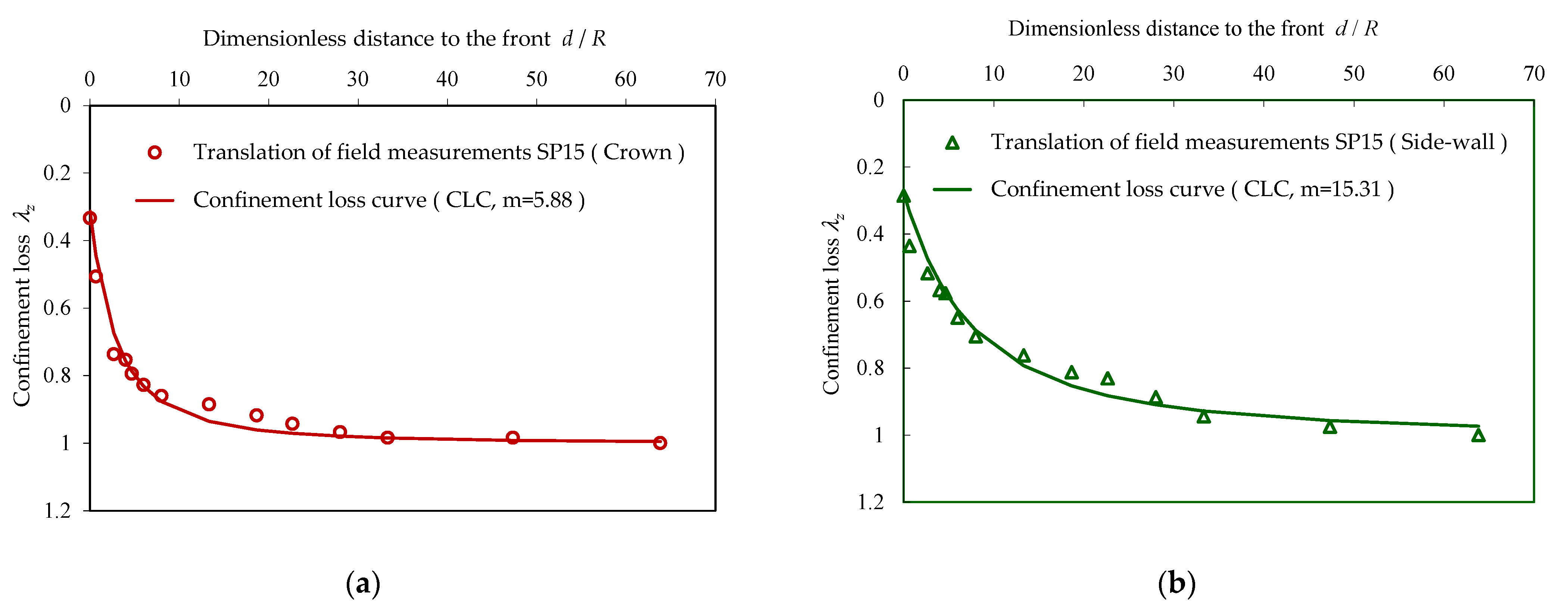

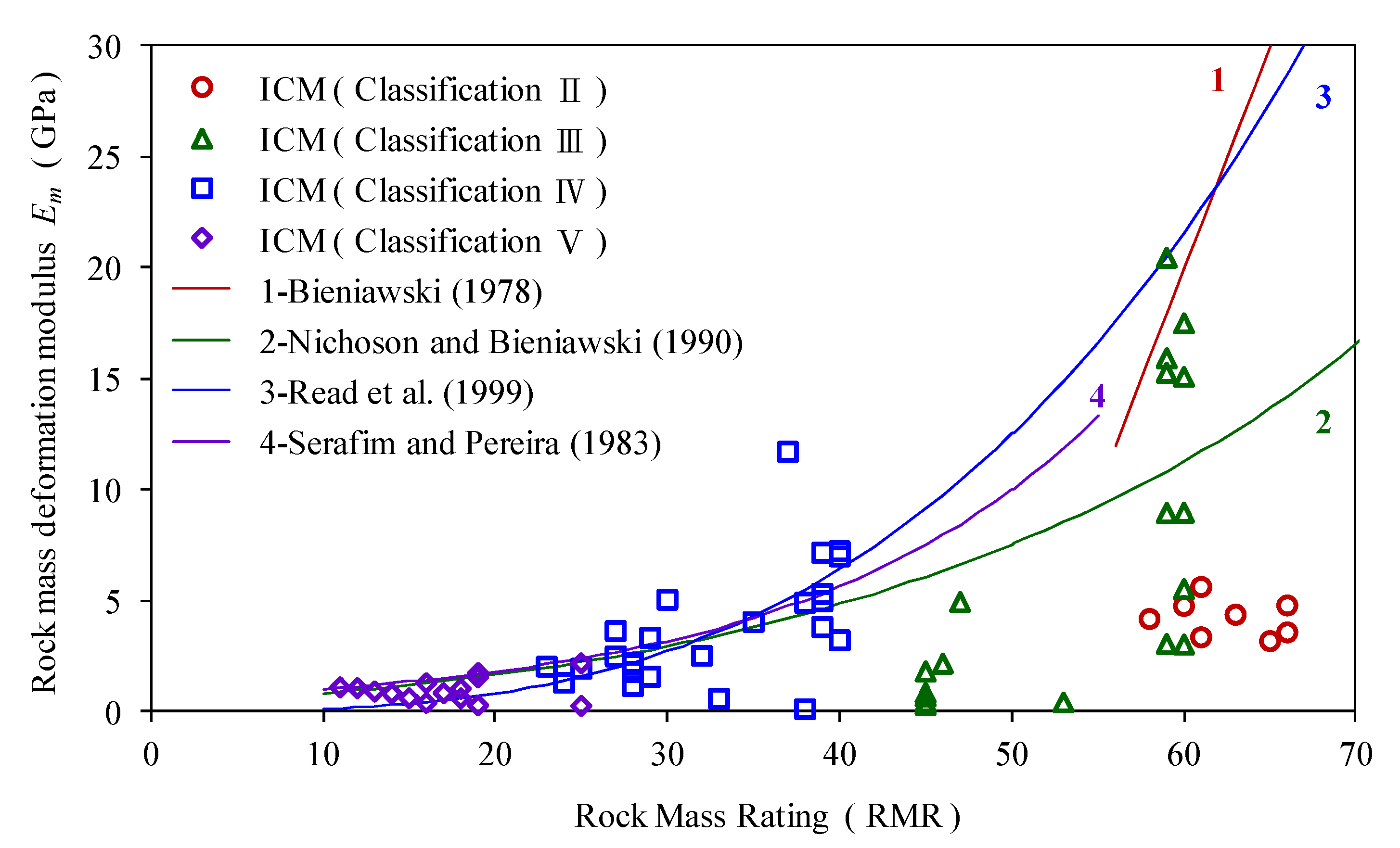

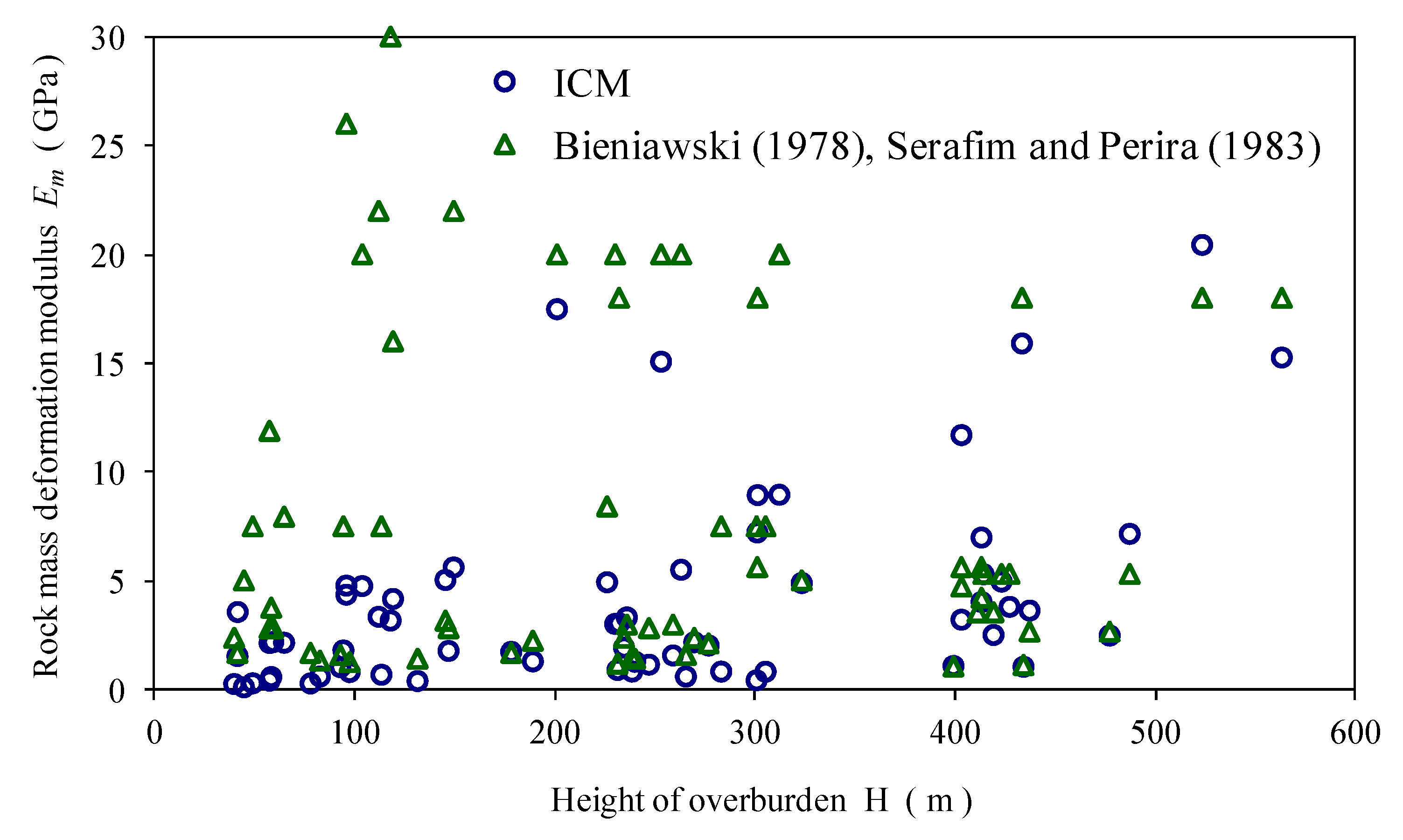
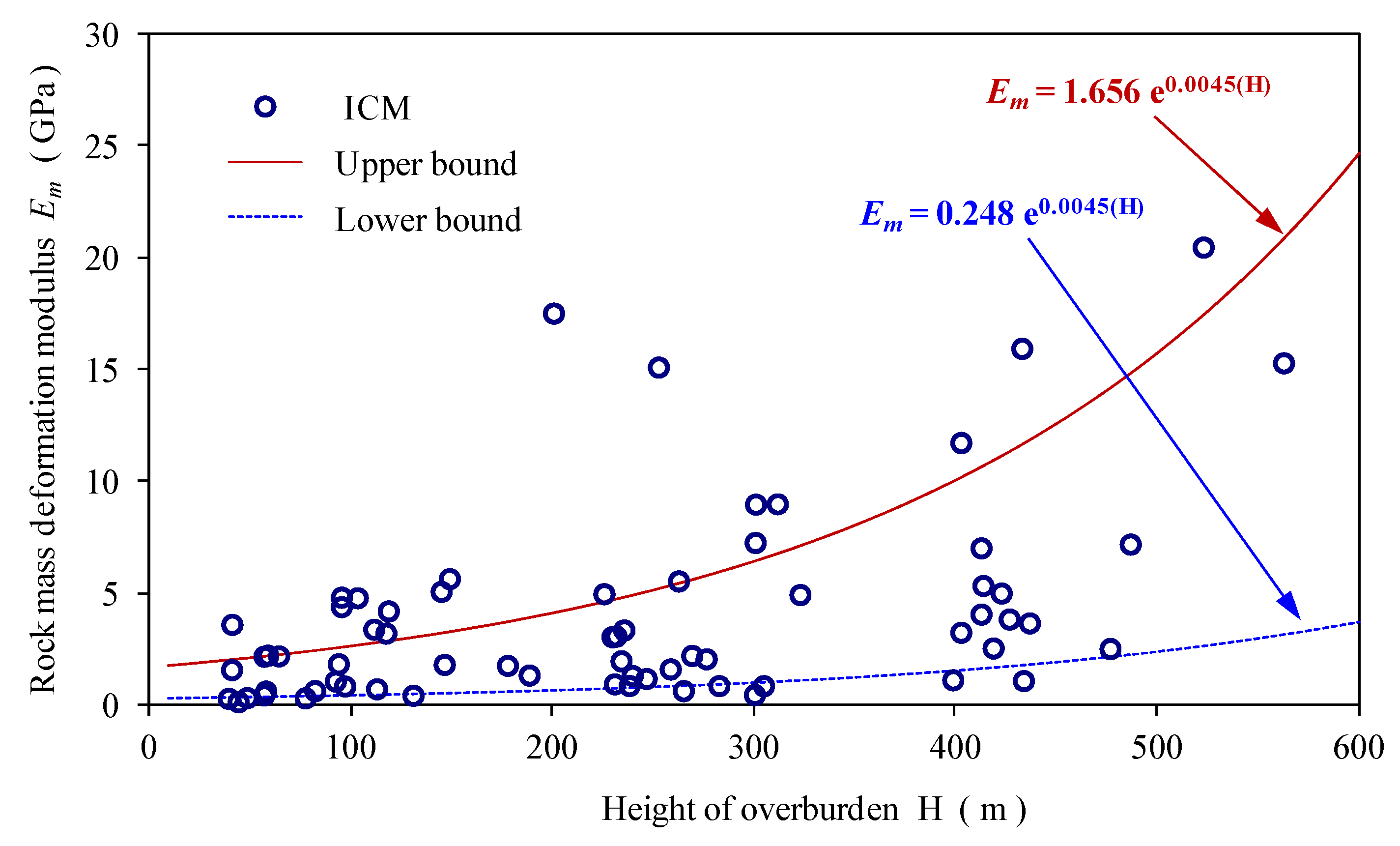
| Rock Mass Properties | Shotcrete-Lining | ||||
|---|---|---|---|---|---|
| Parameter | Value | Parameter | Value | Parameter | Value |
| γ (MPa/m) | 0.027 | c (MPa) | 0.1 | γshot (MPa/m) | 0.025 |
| Em (MPa) | 300.0 | φ (°) | 30.0 | Eshot (GPa) | 25.0 |
| ν | 0.25 | ψ (°) | 30.0 | νshot | 0.2 |
| Ko | 1.0 | R (m) | 5.2 | tshot (m) | 0.2 |
| σv (MPa) | 1.0 | d (m) | 0.53 *, 1.37 ** | σc(shot) (MPa) | 20.0 |
| Analysis Results | DCM Em (MPa) | DCM d (m) | ICM Em (MPa) (Error * %) | ICM d (m) (Error * %) |
|---|---|---|---|---|
| Short unsupported span | 300.0 | 0.53 | 300.0 (0.0%) | 0.532 (0.38%) |
| Long unsupported span | 300.0 | 1.37 | 300.0 (0.0%) | 1.443 (5.33%) |
| Rock Mass Properties | Rock Bolt | Shotcrete-Lining | |||||
|---|---|---|---|---|---|---|---|
| Parameter | Value | Parameter | Value | Parameter | Value | Parameter | Value |
| γ (MPa/m) | 0.027 | c (MPa) | 0.15 | Sc (m) | 1.0 | γshot (MPa/m) | 0.025 |
| Em ** (MPa) | 353.0 | φ (°) | 25.64 | Scl (m) | 1.0 | Eshot (GPa) | 25.0 |
| ν | 0.3 | ψ (°) | 0.0 | l (m) | 6.0 | νshot | 0.2 |
| Ko | 1.0 | R (m) | 6.0 | Eb (GPa) | 207.0 | tshot (m) | 0.05 |
| σv (MPa) | 1.61 | d * (m) | 3.0 | db (mm) | 34.0 | σc(shot) (MPa) | 35.0 |
| Rock Mass Properties | Support Stiffness | ||||
|---|---|---|---|---|---|
| Parameter | Value | Parameter | Value | Parameter | Value |
| γ (MPa/m) | 0.027 | c (MPa) | 0.85 | ks (MPa/m) | 200.0 |
| Em ** (MPa) | 8250.0 | φ (°) | 50.0 | ||
| ν | 0.25 | ψ (°) | 10.0 | ||
| Ko | 1.0 | R (m) | 4.0 | ||
| σv (MPa) | 8.1 | d * (m) | 0.76 | ||
| Rock Mass Properties | Shotcrete-Lining | ||||
|---|---|---|---|---|---|
| Parameter | Value | Parameter | Value | Parameter | Value |
| γ (MPa/m) | 0.027 | c (MPa) | 0.382 | γshot (MPa/m) | 0.025 |
| Em ** (MPa) | 846.0 | φ (°) | 27.35 | Eshot (GPa) | 15.0 |
| ν | 0.35 | ψ (°) | 27.35 | νshot | 0.2 |
| Ko | 1.0 | R (m) | 5.5 | tshot (m) | 0.15 |
| σv (MPa) | 5.0 | d * (m) | 2.0 | σc(shot) (MPa) | 25.0 |
| Other Studies Results | DCM Em (MPa) | DCM d (m) | ICM Em (MPa) (Error * %) | ICM d (m) (Error * %) |
|---|---|---|---|---|
| Rocksupport (2004) Bolt | 353.0 | 3.0 | 353.0 (0.0%) | 3.29 (8.81%) |
| Rocksupport (2004) Bolt + Shotcrete-lining | 353.0 | 3.0 | 353.0 (0.0%) | 3.13 (4.33%) |
| Oreste (2009) | 8250.0 | 0.76 | 8250.0 (0.0%) | 0.76 (0.0%) |
| Gschwandtner-Galler (2012) | 846.0 | 2.0 | 846.0 (0.0%) | 2.15 (7.5%) |
| Section No. | Depth H (m) | Cohesion c (MPa) | Friction Angle φ (deg.) | Poisson’s Ratio ν | RMR * | Em ** (GPa) | Support Stiffness ks (MPa) | Convergence Difference ΔuR (mm) |
|---|---|---|---|---|---|---|---|---|
| SP30 | 403.0 | 0.15 | 20 | 0.33 | 40 | 5.623 | 1302 | 16.3 |
| SP28 | 419.0 | 0.15 | 20 | 0.33 | 32 | 3.548 | 1302 | 16.3 |
| SP21 | 253.0 | 0.25 | 30 | 0.33 | 60 | 20.0 | 868 | 7.8 |
| SP16 | 301.0 | 0.25 | 30 | 0.33 | 47 | 8.414 | 868 | 16.3 |
| SP15 | 301.0 | 0.25 | 30 | 0.33 | 52 | 18.0 | 868 | 8.3 |
| YNS21 | 283.9 | 0.25 | 30 | 0.33 | 45 | 7.499 | 868 | 21.0 |
| YNS17 | 238.5 | 0.10 | 15 | 0.31 | 17 | 1.496 | 1736 | 16.0 |
| YNS15 | 246.9 | 0.15 | 20 | 0.33 | 28 | 2.818 | 1302 | 13.0 |
| YNS9 | 82.6 | 0.10 | 15 | 0.31 | 15 | 1.334 | 1736 | 10.0 |
| YSS23 | 258.9 | 0.15 | 20 | 0.33 | 29 | 2.439 | 1302 | 12.0 |
| YSS12 | 111.9 | 0.35 | 40 | 0.31 | 61 | 22.0 | 434 | 4.0 |
| YSS9 | 119.1 | 0.35 | 40 | 0.31 | 58 | 16.0 | 434 | 4.0 |
| YSS8 | 94.3 | 0.25 | 30 | 0.33 | 45 | 7.499 | 868 | 4.0 |
Publisher’s Note: MDPI stays neutral with regard to jurisdictional claims in published maps and institutional affiliations. |
© 2022 by the authors. Licensee MDPI, Basel, Switzerland. This article is an open access article distributed under the terms and conditions of the Creative Commons Attribution (CC BY) license (https://creativecommons.org/licenses/by/4.0/).
Share and Cite
Lee, Y.-L.; Kao, W.-C.; Chen, C.-S.; Ma, C.-H.; Hsieh, P.-W.; Lee, C.-M. Inverse Analysis for the Convergence-Confinement Method in Tunneling. Mathematics 2022, 10, 1223. https://doi.org/10.3390/math10081223
Lee Y-L, Kao W-C, Chen C-S, Ma C-H, Hsieh P-W, Lee C-M. Inverse Analysis for the Convergence-Confinement Method in Tunneling. Mathematics. 2022; 10(8):1223. https://doi.org/10.3390/math10081223
Chicago/Turabian StyleLee, Yu-Lin, Wei-Cheng Kao, Chih-Sheng Chen, Chi-Huang Ma, Pei-Wen Hsieh, and Chi-Min Lee. 2022. "Inverse Analysis for the Convergence-Confinement Method in Tunneling" Mathematics 10, no. 8: 1223. https://doi.org/10.3390/math10081223
APA StyleLee, Y.-L., Kao, W.-C., Chen, C.-S., Ma, C.-H., Hsieh, P.-W., & Lee, C.-M. (2022). Inverse Analysis for the Convergence-Confinement Method in Tunneling. Mathematics, 10(8), 1223. https://doi.org/10.3390/math10081223







